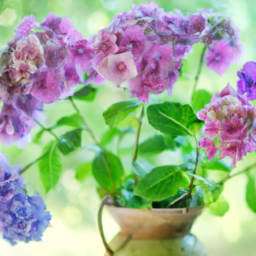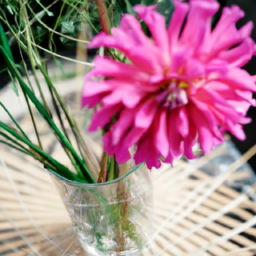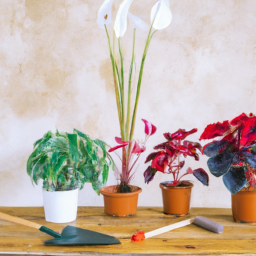
Welcome to our blog post on how to keep your plants happy and thriving during the scorching summer months. In this article, we will explore the key strategies and tips to achieve Summer Splendor: Beating the Heat for Happy Plants. As the temperature rises and the sun shines brighter, it’s essential to provide our leafy friends with the care they need to withstand the heat and flourish. Whether you’re a seasoned gardener or a beginner plant parent, we’ve got you covered with practical advice and expert insights to ensure your plants stay cool, hydrated, and vibrant all summer long. So, let’s dive in and discover the secrets to creating a summer oasis for your beloved green companions.
Importance of Proper Watering Techniques for Healthy Summer Plants
As an expert in gardening, I understand the importance of proper watering techniques for maintaining healthy summer plants. With soaring temperatures and increased evaporation rates, it is crucial to provide adequate water to your plants to ensure their survival and flourishing growth. In this guide, I will walk you through the essential steps and tips to beat the heat and keep your plants happy during the summer season.
Understanding the Water Needs of Plants
Before diving into the watering techniques, it is essential to understand the water needs of different plants. Each plant has unique requirements, and it is crucial to consider factors such as plant type, size, stage of growth, and environmental conditions. Some plants may prefer drier soil, while others thrive in consistently moist conditions.
Observation is key when it comes to watering your plants. Monitor the soil moisture regularly by inserting your finger into the soil. If it feels dry up to the first knuckle, it’s time to water. However, if the soil feels moist, it’s best to hold off watering to prevent overwatering, which can lead to root rot and other plant diseases.
Additionally, pay attention to the weather conditions. During hot and dry spells, plants may require more frequent watering, while cooler and rainy periods may require less. Adjust your watering schedule accordingly to meet the specific needs of your plants.
The Best Watering Techniques for Summer Plants
Now that we understand the importance of proper watering, let’s explore some effective techniques to keep your summer plants healthy:
1. Deep Watering: Shallow watering only wets the surface of the soil, leading to shallow root growth. Instead, aim for deep watering sessions that penetrate the root zone. This encourages the roots to grow deeper, making the plants more resilient to drought conditions. Use a soaker hose or drip irrigation system to deliver water directly to the base of the plants, allowing it to slowly seep into the soil.
2. Watering in the Morning: Watering your plants early in the morning is ideal as it allows the foliage to dry out during the day, reducing the risk of fungal diseases. Additionally, morning watering ensures that the plants have sufficient moisture to withstand the heat of the day. Avoid watering in the evening or at night, as prolonged moisture on the leaves can promote fungal growth.
3. Mulching: Applying a layer of organic mulch around your plants helps to conserve soil moisture by reducing evaporation. Mulch also acts as an insulator, keeping the soil temperature more stable and protecting the roots from extreme heat. Spread a 2-3 inch layer of mulch around the base of your plants, making sure to keep it a few inches away from the stems to prevent rotting.
Additional Tips for Successful Watering
Here are a few extra tips to ensure your watering efforts are successful:
1. Watering Frequency: Rather than sticking to a strict watering schedule, it’s crucial to water your plants based on their specific needs. Adjust the frequency of watering depending on the weather conditions, plant type, and soil moisture levels. Remember, it’s better to underwater than overwater.
2. Avoid Overhead Watering: While it may be tempting to use a sprinkler or hose nozzle to water your plants, overhead watering can lead to wet foliage, making them more susceptible to diseases. Direct the water at the base of the plants to ensure it reaches the root zone.
3. Monitor Soil Drainage: Good soil drainage is essential for healthy plants. If your soil retains water for too long, it may indicate poor drainage. Consider amending the soil with organic matter or creating raised beds to improve drainage and prevent waterlogged roots.
By following these watering techniques and tips, you can ensure the summer splendor of your plants while beating the heat. Remember, observing your plants’ needs and adapting your watering practices accordingly is the key to maintaining healthy and happy plants throughout the summer season.

Summer Splendor: Beating the Heat for Happy Plants
2. Choosing the Right Shade and Sunlight Exposure for Heat-Tolerant Plants
When it comes to ensuring the health and happiness of your plants during the scorching summer months, one of the key factors to consider is the amount of shade and sunlight exposure they receive. Choosing the right shade and sunlight exposure for heat-tolerant plants can make a significant difference in their overall well-being. In this guide, we will take an analytical approach to help you understand how to make the best decisions for your plants.
Understanding Shade and Sunlight Needs
Before diving into the specifics of choosing the right shade and sunlight exposure, it’s important to understand the different needs of plants in terms of light. Some plants thrive in full sun, while others prefer partial shade or even full shade. It all depends on the plant’s natural habitat and its ability to tolerate heat. By understanding these needs, you can ensure that your plants receive the optimal amount of light.
For heat-tolerant plants, it’s generally recommended to provide them with at least six hours of direct sunlight per day. However, this can vary depending on the specific plant species. Some plants may require more sunlight, while others may do well with less. It’s crucial to research the light requirements of each plant you intend to grow to make informed decisions.
In addition to sunlight, shade is equally important. Shade helps protect plants from excessive heat and prevents them from drying out. However, it’s essential to strike the right balance. Too much shade can hinder plant growth and result in weak, leggy stems. On the other hand, too much direct sunlight can cause sunburn and scorching of leaves. Finding the perfect balance between shade and sunlight is key.
Assessing Your Garden’s Sun and Shade Patterns
Now that you understand the importance of shade and sunlight, it’s time to assess your garden’s sun and shade patterns. Spend a day observing how the sun moves across your garden. Take note of areas that receive full sun, partial shade, and full shade at different times of the day. This will give you a better understanding of the microclimates within your garden.
Once you have identified the sun and shade patterns, match them with the light requirements of your heat-tolerant plants. Place the plants that require full sun in areas that receive the most direct sunlight throughout the day. Similarly, position plants that prefer partial shade in areas that receive a combination of sun and shade. Finally, reserve the fully shaded areas for plants that thrive in low-light conditions.
Remember that the sun and shade patterns in your garden may change throughout the year due to factors such as the angle of the sun and the growth of nearby trees or structures. Regularly reassessing your garden’s sun and shade patterns will help you make necessary adjustments to ensure your plants receive the right amount of light.
Providing Artificial Shade and Sun Protection
In some cases, the natural shade and sunlight patterns in your garden may not be sufficient to meet the needs of your heat-tolerant plants. In such situations, you can provide artificial shade and sun protection to create a more suitable environment for your plants.
One effective method is to use shade cloth or shade sails. These materials can be easily installed over specific areas of your garden to filter sunlight and create shade. Shade cloth comes in different densities, allowing you to choose the level of shade required for your plants. This method is particularly useful for areas that receive intense sunlight during the hottest parts of the day.
Another option is to use umbrellas or canopies to provide temporary shade for potted plants or delicate flowers. These portable shade solutions can be moved around as needed to protect your plants from excessive heat and sunlight. Just ensure that the umbrellas or canopies are securely anchored to prevent them from toppling over in strong winds.
Lastly, consider using mulch to protect the soil and plant roots from heat stress. A layer of organic mulch, such as wood chips or straw, helps retain soil moisture and regulate soil temperature. It also acts as a natural barrier against weed growth, reducing competition for nutrients and water. Apply a thick layer of mulch around the base of your plants, leaving a small gap around the stems to prevent rotting.
By incorporating these artificial shade and sun protection methods, you can create a more favorable environment for your heat-tolerant plants, ensuring their growth and vitality even during the hottest summer days.
Conclusion
Choosing the right shade and sunlight exposure for heat-tolerant plants is crucial for their overall well-being. By understanding the light requirements of your plants, assessing your garden’s sun and shade patterns, and providing artificial shade and sun protection when necessary, you can create an optimal environment for your plants to thrive. Remember to regularly monitor and adjust the shade and sunlight conditions as needed to ensure the continued health and happiness of your plants throughout the summer season.

Effective Strategies for Protecting Plants from Summer Heat Stress
Summer can be a challenging time for plants, as the scorching heat and intense sunlight can cause stress and damage. However, with the right strategies in place, you can ensure that your plants thrive and remain happy throughout the season. In this guide, we will explore some effective ways to beat the heat and protect your plants from summer heat stress.
1. Provide Ample Water
Water is essential for plants to survive, especially during hot summer months. Ensure that your plants receive an adequate amount of water to keep them hydrated and cool. The key is to water deeply and infrequently, allowing the roots to absorb moisture from deeper in the soil.
Consider installing a drip irrigation system or using soaker hoses to deliver water directly to the plant’s root zone. This method reduces water loss due to evaporation and ensures that the water reaches where it is needed the most.
Monitor the moisture levels in the soil regularly. Stick your finger into the soil to check for moisture about an inch below the surface. If it feels dry, it’s time to water your plants. However, be cautious not to overwater, as this can lead to root rot and other issues.
2. Mulch, Mulch, Mulch
Mulching is a fantastic way to protect your plants from the scorching summer heat. Apply a layer of organic mulch, such as wood chips or straw, around the base of your plants. Mulch helps retain soil moisture, prevents weed growth, and acts as an insulating layer, keeping the roots cool.
Spread a layer of mulch about 2-3 inches thick around your plants, making sure to leave a small gap around the stem to prevent rotting. Mulch also adds nutrients to the soil as it breaks down over time, promoting healthy plant growth.
Remember to replenish the mulch periodically, as it may break down or get washed away during heavy rains. This will ensure that your plants continue to receive the benefits of mulching throughout the summer.
3. Provide Shade and Shelter
Just like us, plants need shade and shelter from the scorching sun to stay cool and protected. Consider creating shade structures or using shade cloth to provide relief to your plants during the hottest parts of the day.
Strategically place tall plants or use trellises to provide shade to more delicate plants that cannot tolerate direct sunlight. You can also use umbrellas or shade sails to create temporary shade in areas where plants are exposed to intense sunlight for extended periods.
Additionally, consider using row covers or netting to shield your plants from excessive heat and protect them from pests. These covers allow air and light to pass through while providing a barrier against intense heat and unwanted visitors.
Remember to monitor the temperature and adjust the shade structures accordingly to ensure that your plants receive the right amount of shade without being deprived of sunlight entirely.
By following these effective strategies, you can protect your plants from summer heat stress and ensure their health and happiness throughout the season. Remember to stay attentive to your plants’ needs, provide regular care, and make adjustments as necessary. With a little extra effort, your plants will thrive and bring beauty to your garden even in the hottest months of the year.
Here’s the Summary Snapshot
Summer is finally here, and while we humans may be excited for beach days and barbecues, our plants might not be feeling the same enthusiasm. The scorching heat can take a toll on our green friends, but fear not! With a little care and attention, we can ensure our plants stay happy and healthy throughout the summer.
First and foremost, it’s crucial to keep our plants hydrated during the hot months. Just like us, they need plenty of water to thrive. However, it’s important to strike the right balance. Overwatering can be just as harmful as underwatering, so we should aim to provide our plants with a steady supply of moisture without drowning them. Additionally, we can help our plants beat the heat by providing them with some shade. Placing them in a spot where they receive a few hours of direct sunlight in the morning or evening, while being shielded from the intense midday sun, can make a world of difference. Finally, don’t forget to give your plants some extra love by regularly checking for pests, providing proper ventilation, and fertilizing them to ensure they have all the nutrients they need to thrive. With these simple steps, we can keep our plants cool, happy, and flourishing all summer long.
Q&A Corner:
Q1: How can I protect my plants from the summer heat?
A1: To protect your plants from the scorching summer heat, there are a few measures you can take. First, consider providing ample shade for your plants by using shade cloths, umbrellas, or placing them under a tree. Additionally, mulching around the base of your plants can help retain moisture and regulate soil temperature. Regular watering, preferably in the early morning or late evening, is crucial to keep your plants hydrated. Lastly, consider using a layer of organic compost to help insulate the roots and retain moisture.
Q2: What are some heat-tolerant plants that thrive during the summer?
A2: If you’re looking for plants that can withstand the summer heat, there are several great options to choose from. Some heat-tolerant plants include succulents like cacti and agave, as well as ornamental grasses such as fountain grass and purple muhly grass. Additionally, you can consider planting heat-loving flowers like marigolds, zinnias, and sunflowers. These plants have adapted to thrive in hot conditions and will add vibrant colors to your garden while beating the heat.
Q3: How often should I water my plants during the summer?
A3: Watering requirements can vary depending on the type of plant, soil conditions, and climate. However, as a general guideline, it is recommended to water your plants deeply and infrequently during the summer. Aim to provide at least 1 inch of water per week, either through rainfall or irrigation. It’s crucial to monitor the moisture level of the soil by checking the top few inches with your finger. If it feels dry, it’s time to water. Remember, it’s better to water deeply once or twice a week rather than shallowly every day.
Q4: How can I keep potted plants cool in the summer?
A4: Keeping potted plants cool in the summer is essential to prevent them from overheating. One effective method is to move your pots to a shaded area, away from direct sunlight during the hottest parts of the day. You can also place the pots on a tray filled with water, creating a humid microclimate around the plants. This helps to cool the surrounding air and keeps the plants hydrated. Additionally, using light-colored or reflective pots can reduce heat absorption and keep the roots cooler.
Q5: What signs should I look for to identify heat stress in my plants?
A5: It’s important to be able to identify signs of heat stress in your plants to take appropriate action. Some common indicators include wilting or drooping leaves, yellowing or browning of foliage, and leaf scorching. Plants may also exhibit slowed growth or have a general lack of vigor. If you notice any of these symptoms, it’s a sign that your plants are struggling with the heat. Providing shade, adjusting watering practices, and ensuring proper ventilation can help alleviate heat stress and revive your plants.

James Wong is a renowned ethnobotanist, plant scientist, and local television presenter. With a passion for demystifying plant science, he is known for translating complex botanical concepts into practical advice for everyday plant enthusiasts. James’s expertise spans from traditional gardening to cutting-edge plant technologies, making his insights accessible and informative.


